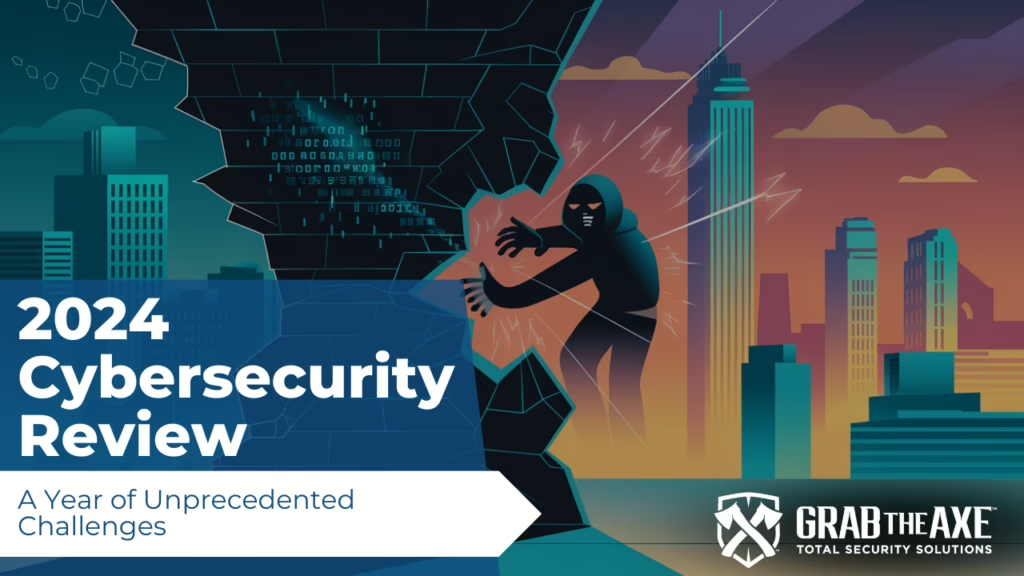As we step into 2025, it’s crucial to reflect on the seismic shifts in the cybersecurity landscape over the past year. 2024 was marked by some of the most sophisticated and impactful cyberattacks to date. These incidents targeted critical infrastructure, healthcare, cloud providers, and even global supply chains, forcing organizations and governments to reevaluate their cybersecurity strategies. From state-sponsored espionage campaigns to massive data breaches, these events underscore the need for advanced defenses and proactive collaboration to combat an ever-evolving threat landscape.
Overview of the 2024 Cybersecurity Landscape
The global rise in cyber incidents throughout 2024 painted a stark picture for businesses and governments alike. According to industry reports, ransomware attacks accounted for over 40% of major breaches, while supply chain vulnerabilities left organizations reeling from cascading impacts. Critical sectors such as healthcare, finance, and energy became frequent targets, underscoring the necessity of robust security measures.
Key statistics:
- Estimated global economic loss from cybercrime reached $10.5 trillion.
- The healthcare sector alone reported a 50% increase in ransomware incidents compared to 2023.
- Over 70% of organizations cited cloud misconfigurations as a leading cause of data breaches.
Breaking Down Threat Types in the 2024 Cybersecurity Review
1. Ransomware Evolution
Ransomware attacks continued to dominate, with threat actors deploying double and even triple extortion tactics. Beyond encrypting data, attackers threatened to release sensitive information and targeted victims’ customers and partners directly to amplify pressure.
Explore effective strategies to protect your organization against evolving ransomware threats
2. AI-Driven Phishing and Social Engineering
Generative AI transformed the phishing landscape, enabling attackers to craft hyper-realistic emails and voice simulations. This sophistication made business email compromise (BEC) attacks increasingly effective, with deepfake impersonation of executives becoming a widespread issue.
3. Supply Chain Exploits
Attackers focused on third-party vendors to infiltrate organizations. The global software supply chain attack in Q2 was particularly notable, impacting over 200 enterprises and highlighting the interconnected vulnerabilities in modern business ecosystems.
High-profile supply chain compromises impacted thousands of victims in 2023, highlighting the risks of interconnected systems (2024 Report on the Cybersecurity Posture of the United States, 2024).
4. Critical Infrastructure Threats
Nation-state actors targeted utilities, transportation systems, and public safety networks, creating significant disruptions and exposing gaps in critical infrastructure security.
Nation-state threats, particularly from the People’s Republic of China (PRC), posed unprecedented risks to critical infrastructure in 2023, including pre-positioning attacks aimed at operational technology systems (2024 Report on the Cybersecurity Posture of the United States, 2024).
Find out how to mitigate Advanced Persistent Threats with these seven critical steps.
5. Cloud Vulnerability Exploits
The migration to cloud-based systems opened new attack surfaces. Misconfigured environments and zero-day vulnerabilities enabled hackers to access sensitive data from millions of users.
Discover 2024’s best practices for securing cloud environments against vulnerabilities and breaches.
Top 10 Cyberattacks of 2024
1. Change Healthcare Ransomware Attack
In February 2024, Change Healthcare, a subsidiary of UnitedHealth Group, suffered a crippling ransomware attack orchestrated by the ALPHV/BlackCat group. This attack disrupted healthcare services nationwide, delaying critical prescriptions and surgical procedures. Over 100 million individuals had their sensitive medical and insurance data exposed, marking one of the most significant healthcare breaches in history.
Despite deploying extensive cybersecurity measures, the company ultimately paid a $22 million ransom to restore operations. This incident reignited conversations about the vulnerabilities of healthcare organizations and the urgent need for robust ransomware defenses and stricter data protection measures.
The Federal Bureau of Investigation (FBI) reported a 22% increase in ransomware incidents in 2023, with costs rising by 74% compared to the previous year (2024 Report on Cybersecurity and Resilience, 2024).
2. Snowflake Data Breach
In April 2024, attackers exploited weak security practices at Snowflake, a leading cloud storage and data analytics provider, to access customer data. Notable victims included AT&T, with 70 million customer records compromised, and Ticketmaster, which suffered the theft of 560 million records. The Scattered Spider hacking group was linked to the breach, using stolen credentials and bypassing inadequate multifactor authentication protocols.
This breach emphasized the vulnerabilities inherent in cloud platforms and the importance of adopting Zero Trust principles and enhanced identity verification measures to safeguard sensitive data.
3. Chinese Espionage Campaigns: Volt Typhoon and Salt Typhoon
Chinese state-sponsored groups conducted two notable campaigns in 2024. Volt Typhoon infiltrated critical U.S. infrastructure networks, such as power grids and communications systems, positioning itself to disrupt services during geopolitical tensions. Simultaneously, Salt Typhoon targeted telecommunications giants, including AT&T and Verizon, compromising metadata and communications of political figures.
These campaigns highlighted the persistent threats posed by nation-state actors and the importance of securing critical infrastructure from advanced persistent threats (APTs) through continuous monitoring and enhanced cooperation between public and private sectors.
4. XZ Utils Supply Chain Attack
In March 2024, the XZ Utils backdoor attack (CVE-2024-3094) sent shockwaves through the software industry. Hackers embedded malicious code into a widely used compression utility, which then propagated to thousands of downstream systems globally. The breach demonstrated the vulnerability of software supply chains and the catastrophic potential of small, overlooked components in widespread systems.
This incident underscored the necessity of implementing Software Bills of Materials (SBOMs) and rigorous vetting of third-party software components in mitigating supply chain risks.
5. National Public Data Breach
In April 2024, hackers breached National Public Data’s systems, exfiltrating 2.9 billion records containing sensitive personal information, including Social Security numbers and phone numbers. This data was later sold on the dark web for $3.5 million, exposing millions to identity theft and fraud.
The breach renewed debates over the role of data brokers in collecting, storing, and monetizing vast amounts of personal information without robust cybersecurity measures. Calls for stricter regulations on data privacy and accountability surged following the incident.
6. ALPHV/BlackCat Infrastructure Takedown
In December 2024, international law enforcement dismantled the infrastructure of the ALPHV/BlackCat ransomware group. This operation disrupted the group’s activities and enabled the recovery of stolen data. Over the year, the group had targeted thousands of victims, extracting millions in ransoms.
The takedown highlighted the power of global collaboration in combating ransomware and the need for coordinated law enforcement efforts to dismantle cybercriminal networks.
7. Qakbot Botnet Neutralization
In August 2024, U.S. and international law enforcement agencies successfully dismantled the Qakbot botnet, a key enabler of ransomware and financial fraud. Authorities deployed a custom script to remove malware from infected systems, seized command-and-control servers, and recovered $8.6 million in illicit cryptocurrency.
This operation demonstrated the effectiveness of proactive measures in disrupting major cybercriminal ecosystems and protecting millions of potential victims.
8. Healthcare IoT Exploitation
A sophisticated attack on a major healthcare provider exploited Internet of Things (IoT) devices, including patient monitors and infusion pumps. The attackers leveraged default credentials and unpatched vulnerabilities to disrupt hospital operations and compromise patient data.
This incident underscored the growing risks of connected medical devices and the urgent need for regulatory frameworks to ensure their security.
9. Global Transportation Network DDoS Attack
In October, a Distributed Denial of Service (DDoS) attack targeted a major metropolitan transportation network, crippling scheduling systems and causing severe commuter disruptions during peak hours. Hacktivist groups claimed responsibility, highlighting vulnerabilities in public infrastructure systems.
The attack highlighted the importance of deploying DDoS mitigation technologies and increasing investment in resilient public infrastructure.
10. Telecommunications Metadata Breach
Hackers targeted a major telecommunications provider, stealing metadata and communications records from millions of users. This attack exposed critical privacy concerns and demonstrated the need for robust API security measures to protect against unauthorized access.
In response, telecommunications providers began investing in API gateways, threat detection tools, and employee training to safeguard sensitive data.
Most Prominent Cyber Outages and Responses
CrowdStrike’s Role
CrowdStrike and other leading cybersecurity firms played crucial roles in mitigating the year’s most significant threats. Their advanced threat intelligence and swift response capabilities helped minimize damage during attacks on critical infrastructure and major corporations.
Critical Infrastructure Failures
- Energy grids and transportation networks faced targeted ransomware and DDoS attacks, exposing gaps in preparedness and incident response.
- Prolonged outages underscored the importance of public-private partnerships to safeguard essential services.
Lessons from Incident Response
Successful recoveries highlighted the value of:
- Zero Trust architectures to limit lateral movement.
- Comprehensive incident response plans to minimize downtime.
- Ongoing security training to address human vulnerabilities.
Crucial Lessons from the 2024 Cybersecurity Review
The cyber landscape in 2024 revealed critical takeaways for organizations:
- Adopt Zero Trust Principles:
- Restrict access, continuously verify users, and enforce least-privilege policies.
- Adopting Zero Trust Architecture remains critical for organizations to mitigate risks from lateral movement during breaches and enhance endpoint security (2024 Report on Cybersecurity and Resilience, 2024).
- Invest in AI-Driven Security:
- Leverage machine learning to predict, detect, and respond to threats in real time.
- With cybercrime costs projected to reach $10.5 trillion globally by 2024, proactive investment in AI-driven security tools for real-time threat detection and predictive analytics is imperative for enhancing cybersecurity resilience (2024 Report on Cybersecurity and Resilience, 2024).
- Secure the Supply Chain:
- Collaborate with vendors to identify and mitigate shared vulnerabilities.
- Focus on Employee Training:
- Regularly update training to address evolving phishing and social engineering tactics.
Strategic Takeaways for Cybersecurity in 2025
As 2025 begins, these incidents underscore the need for:
- Proactive Defense: Implementing Zero Trust Architecture and SBOMs to mitigate risks.
- Collaboration: Strengthening public-private partnerships for threat intelligence sharing.
- Regulation: Establishing robust data privacy laws and IoT security standards.
- Preparedness: Enhancing incident response plans to limit the impact of cyberattacks.
Preparing for the Next Wave of Cybersecurity in 2025
As organizations brace for emerging threats, including quantum computing risks and expanding IoT vulnerabilities, the emphasis will shift towards proactive strategies. Partnerships between governments, businesses, and security providers will be critical in addressing the complexities of modern cyber threats.
Your Security, Our Mission At Grab The Axe, we stand ready to help you navigate these challenges with confidence. From custom solutions to expert guidance, we are your trusted partner in fortifying defenses against an ever-changing threat landscape.
For more insights and actionable advice, visit our Insights Page.
References
2024 Report on Cybersecurity and Resilience. (2024, June 30). FDIC: Federal Deposit Insurance Corporation. https://www.fdic.gov/system/files/2024-08/2024-cybersecurity-financial-system-resilience-report.pdf
2024 REPORT ON THECYBERSECURITY POSTURE OF THE UNITED STATES. (2024, May). The White House. https://www.whitehouse.gov/wp-content/uploads/2024/05/2024-Report-on-the-Cybersecurity-Posture-of-the-United-States.pdf
(n.d.). Access Denied. https://www.dni.gov/files/ODNI/documents/assessments/ATA-2024-Unclassified-Report.pdf
Baran, G. (2024, December 30). Top 10 cyber attacks of 2024. Cyber Security News. https://cybersecuritynews.com/top-10-cyber-attacks-of-2024/
Burt, J. (2024, December 26). Top 10 cyberattacks of 2024. MSSP Alert. https://www.msspalert.com/news/a-look-at-some-of-the-biggest-cyberattacks-of-2024
Coker, J. (2024, December 2). Top 10 cyber-attacks of 2024. Infosecurity Magazine. https://www.infosecurity-magazine.com/news-features/top-cyber-attacks-2024/





